Water Volume Variations Estimation and Analysis Using Multisource Satellite Data: A Case Study of Lake Victoria
Abstract
1. Introduction
2. Study Area
3. Data
3.1. Multi-Mission Altimetry Data
3.2. Multi-Spectral Imagery
3.3. Satellite Gravimetry
4. Method
4.1. Water Surface Level
4.2. Water Surface Area
4.3. Water Volume Variations Estimation
5. Results and Discussion
5.1. Results of Lake Surface Level and
5.2. Results of Lake Surface Area
5.3. Results of Water Volume Variations Estimation
5.3.1. and Relationship Models
5.3.2. Water Volume Variations over the Past 15 Years
5.3.3. Multi-Timescale Analysis
6. Conclusions
- The maximum lake surface level observed is 1119.61 m, which appears on 11 May 2016, and the minimum surface level is 1117.30 m, which appears on 21 October 2006. The maximum change in water level in the 15 years is 2.31m.
- The maximum area of the lake is 66,176.25 km2, occurred on 11 July 2016, while the minimum is 65,700.25 km2, occurred on 18 June 2006. The average surface area of Lake Victoria over the past 15 years (2003–2017) is 65,925.97 km2. During this period, the maximum surface area of the water changes by more than 1700 km2. The largest change in one year reaches 276.5 km2.
- Lake water level is an important parameter for the relationship between lake area and water volume. At the same time, there are significant correlations between and . The simulation analysis of four models, linear, polynomial, power, and exponential, determine that the relationship between the area of Lake Victoria and the water level are exponential in a certain range. The exponential model has the highest correlation coefficient (R2 = 0.8810, RMSE = 38.45).
- The estimated maximum water volume variation during the 15 years is 152.9 km3. The relationship-derived water volume variations match well with the GRACE-derived TWS changes. The shows an increase trend over the past 15 years and its fluctuations can be divided into four periods: (1) sharp drop from 2003 to 2006; (2) relatively stable from 2007 to 2011; (3) gradual increase from 2012 to 2016; and (4) sharp drop from 2016 to 2017.
- There is a bimodal pattern in the intra-annual water volume variations, which is consistent with the changes in precipitation. As precipitation has a large seasonal variation with obvious bimodal changes, climate conditions have a great influence on water volume of Lake Victoria.
- After using Morlet wavelet to study the lake variation period, we found that the first main cycle of water volume change is 18 months (1.5 a) over the past 15 years, while the second main cycle is 9 months (0.75 a).
Author Contributions
Funding
Acknowledgments
Conflicts of Interest
References
- Crétaux, J.F.; Birkett, C. Lake Studies from Satellite Radar Altimetry. Comptes Rendus Geosci. 2006, 338, 1098–1112. [Google Scholar] [CrossRef]
- Forsythe, K.W.; Schatz, B.; Swales, S.J.; Ferrato, L.J.; Atkinson, D.M. Visualization of lake mead surface area changes from 1972 to 2009. ISPRS Int. J. Geo Inf. 2012, 1, 108–119. [Google Scholar] [CrossRef]
- Zhang, G.Q.; Yao, T.D.; Chen, W.F.; Zheng, G.X.; Shum, C.K.; Yang, K.; Piao, S.L.; Sheng, Y.W.; Yi, S.; Li, J.L.; et al. Regional differences of lake evolution across China during 1960s–2015 and its natural and anthropogenic causes. Remote Sens. Environ. 2019, 221, 386–404. [Google Scholar] [CrossRef]
- Feng, L.; Hu, C.; Chen, X.; Cai, X.; Tian, L.; Gan, W. Assessment of inundation changes of Poyang Lake using MODIS observations between 2000 and 2010. Remote Sens. Environ. 2012, 121, 80–92. [Google Scholar] [CrossRef]
- Cre’taux, J.-F.; Letolle, R.; Calmant, S. Investigations on Aral Sea regressions from mirabilite deposits and remote sensing. Aquat. Geochem. 2009, 15, 277–291. [Google Scholar] [CrossRef]
- De Wit, M.; Stankiewicz, J. Changes in surface water supply across Africa with predicted climate change. Science 2006, 311, 1917–1921. [Google Scholar] [CrossRef]
- Adrian, R.; O’Reilly, C.M.; Zagarese, H.; Baines, S.B.; Hessen, D.O.; Keller, W.; Livingstone, D.M.; Sommaruga, R.; Straile, D.; Van Donk, E.; et al. Lakes as sentinels of climate change. Limnol. Oceanogr. 2009, 54, 2283–2297. [Google Scholar] [CrossRef]
- Abileah, R.; Vignudelli, S.; Scozzari, A. A completely remote sensing approach to monitoring reservoirs water volume. Int. Water Technol. J. 2011, 1, 63–77. [Google Scholar]
- Birkett, C.M. The global remote sensing of lakes, wetlands and rivers for hydrological and climate research. Quant. Remote Sens. Sci. Appl. 1995, 3, 1979–1981. [Google Scholar] [CrossRef]
- Birkett, C.M.; Beckley, B. Investigating the Performance of the JASON-2/OSTM Radar Altimeter over Lakes and Reservoirs. Mar. Geod. 2010, 33, 204–238. [Google Scholar] [CrossRef]
- Frappart, F.; Minh, K.D.; L’Hermitte, J.; Cazenave, A.; Ramillien, G.; Le Toan, T.; Mognard-Campbell, N. Water volume change in the lower Mekong from satellite altimetry and imagery data. Geophys. J. Int. 2006, 167, 570–584. [Google Scholar] [CrossRef]
- Baghdadi, N.; Lemarquand, N.; Abdallah, H.; Bailly, J.S. The relevance of GLAS/ICESat elevation data for the monitoring of river networks. Remote Sens. 2011, 3, 708–720. [Google Scholar] [CrossRef]
- Silva, J.S.; Calmant, S.; Seyler, F.; Moreira, D.M.; Oliveira, D.; Monteiro, A. Radar altimetry aids managing gauge networks. Water Resour. Manag. 2014, 28, 587–603. [Google Scholar] [CrossRef]
- Kleinherenbrink, M.; Lindenbergh, R.C.; Ditmar, P.G. Monitoring of lake level changes on the Tibetan Plateau and Tian Shan by retracking Cryosat SARIn waveforms. J. Hydrol. 2015, 521, 119–131. [Google Scholar] [CrossRef]
- Furnans, J.; Austin, B. Hydrographic survey methods for determining reservoir volume. Environ. Modeling Softw. 2008, 23, 139–146. [Google Scholar] [CrossRef]
- Wilcox, C.; Huertos, M.L. A simple, rapid method for mapping bathymetry of small wetland basins. J. Hydrol. 2005, 301, 29–36. [Google Scholar] [CrossRef]
- Foteinopoulos, P. Cubic spline interpolation to develop contours of large reservoirs and evaluate area and volume. Adv. Eng. Softw. 2009, 40, 23–29. [Google Scholar] [CrossRef]
- Smith, L.C.; Pavelsky, T.M. Remote sensing of volumetric storage changes in lakes. Earth Surf. Process. Landf. 2009, 34, 1353–1358. [Google Scholar] [CrossRef]
- Frappart, F.; Seyler, F.; Martinez, J.M.; León, J.G.; Cazenave, A. Floodplain water storage in the Negro River basin estimated from microwave remote sensing of inundation area and water levels. Remote Sens. Environ. 2005, 99, 387–399. [Google Scholar] [CrossRef]
- Gao, H.; Birkett, C.M.; Lettenmeir, D.P. Global monitoring of large reservoir storage from satellite remote sensing. Water Resour. Res. 2012, 48, W09504. [Google Scholar] [CrossRef]
- Duan, Z.; Bastiaanssen, W.G.M. Estimating water volume variations in lakes and reservoirs from four operational satellite altimetry databases and satellite imagery data. Remote Sens. Environ. 2013, 134, 403–416. [Google Scholar] [CrossRef]
- Arsen, A.; Cre’taux, J.F.; Berge-Nguyen, M.; del Rio, R.A. Remote sensing derived bathymetry of Lake Poopo. Remote Sens. 2014, 6, 407–420. [Google Scholar] [CrossRef]
- Tong, X.Z.; Pan, H.Y.; Xie, H.; Xu, X.; Li, F.T.; Chen, L.; Luo, X.; Liu, S.J.; Chen, P.; Jin, Y.M. Estimating water volume variations in Lake Victoria over the past 22 years using multi-mission altimetry and remotely sensed images. Remote Sens. Environ. 2016, 187, 400–413. [Google Scholar] [CrossRef]
- Tseng, K.H.; Chang, C.P.; Shum, C.K.; Kuo, C.Y.; Liu, K.T.; Shang, K.; Jia, Y.Y.; Sun, J. Quantifying Freshwater Mass Balance in the Central Tibetan Plateau by Integrating Satellite Remote Sensing, Altimetry, and Gravimetry. Remote Sens. 2016, 8, 441. [Google Scholar] [CrossRef]
- Forootan, E.; Rietbroek, R.; Kusche, J.; Sharifi, M.A.; Awange, J.L.; Schmidt, M.; Omondi, P.; Famiglietti, J. Separation of large scale water storage patterns over Iran using GRACE, altimetry and hydrological data. Remote Sens. Environ. 2014, 140, 580–595. [Google Scholar] [CrossRef]
- Singh, A.; Seitz, F.; Schwatke, C. Inter-annual water storage changes in the Aral Sea from multi-mission satellite altimetry, optical remote sensing, and GRACE satellite gravimetry. Remote Sens. Environ. 2012, 123, 187–195. [Google Scholar] [CrossRef]
- Singh, A.; Seitz, F.; Schwatke, C. Application of multi-sensor satellite data to observe water storage variations. IEEE J. Sel. Top. Appl. Earth Obs. Remote Sens. 2013, 6, 1502–1508. [Google Scholar] [CrossRef]
- Ramillien, G.; Frappart, F.; Seoane, L. Application of the regional water mass variations from GRACE satellite gravimetry to large-scale water management in Africa. Remote Sens. 2014, 6, 7379–7405. [Google Scholar] [CrossRef]
- Llovel, W.; Becker, M.; Cazenave, A. Global land water storage change from GRACE over 2002–2009, inference on sea level. Comptes Rendus Geosci. 2010, 342, 179–188. [Google Scholar] [CrossRef]
- Awange, J.L.; Anyah, R.; Agola, N.; Forootan, E.; Omondi, P. Potential impacts of climate and environmental change on the stored water of Lake Victoria Basin and economic implications. Water Resour. Res. 2013, 49, 8160–8173. [Google Scholar] [CrossRef]
- Tourian, M.J.; Elmi, O.; Chen, Q.; Devaraju, B.; Roohi, S.; Sneeuw, N. A spaceborne multisensor approach to monitor the desiccation of Lake Urmia in Iran. Remote Sens. Environ. 2015, 156, 349–360. [Google Scholar] [CrossRef]
- Vanderkelen, I.; van Lipzig, N.P.M.; Thiery, W. Modelling the water balance of Lake Victoria (East Africa) —Part 1: Observational analysis. Hydrol. Earth Syst. Sci. Discuss. 2018, 1–28. [Google Scholar] [CrossRef]
- Kizza, M.; Rodhe, A.; Xu, C.Y.; Ntale, H.K.; Halldin, S. Temporal rainfall variability in the Lake Victoria Basin in East Africa during the twentieth century. Theor. Appl. Climatol. 2009, 98, 119–135. [Google Scholar] [CrossRef]
- Nicholson, S.E. Climate and climatic variability of rainfall over eastern Africa. Rev. Geophys. 2017, 55, 590–635. [Google Scholar] [CrossRef]
- Bremner, J.; Lopez-Carr, D.; Zvoleff, A.; Pricope, N. Using new methods and data to assess and address population, fertility, and environment links in the Lake Victoria Basin, Population and the environment. In Proceedings of the 2013 International Union for the Scientific Study of Population (IUSSP), Busan, Korea, 26–31 August 2013. [Google Scholar]
- World Lakes Website. Available online: http://www.worldlakes.org/lakedetails.asp?lakeid=8361 (accessed on 1 January 2020).
- MODIS Imagery. Available online: http://ladsweb.nascom.nasa.gov/data/search (accessed on 1 April 2018).
- Jason-1, -2, -3 Altimetry Data. Available online: Ftp://avisoftp.cnes.fr/AVISO/pub/ (accessed on 1 March 2018).
- GRLM Datasets. Available online: https://ipad.fas.usda.gov/cropexplorer/global_reservoir/ (accessed on 1 May 2018).
- GRACE JPL-M Solutions. Available online: https://grace.jpl.nasa.gov/data/get-data/jpl_global_mascons/ (accessed on 12 December 2018).
- Jason-1 Products Handbook. Available online: https://www.aviso.altimetry.fr/fileadmin/documents/data/tools/hdbk_j1_gdr.pdf (accessed on 4 December 2019).
- OSTM/Jason-2 Products Handbook. Available online: https://www.aviso.altimetry.fr/fileadmin/documents/data/tools/hdbk_j2.pdf (accessed on 4 December 2019).
- Jason-3 Products Handbook. Available online: https://www.aviso.altimetry.fr/fileadmin/documents/data/tools/hdbk_j3.pdf (accessed on 4 December 2019).
- Birkett, C.; Reynolds, C.; Beckley, B.; Doorn, B. From Research to Operations: The USDA Global Reservoir and Lake Monitor. In Coastal Altimetry; Vignudelli, S., Kostianoy, A., Cipollini, P., Benveniste, J., Eds.; Springer: Berlin, Germany, 2011; pp. 19–50. [Google Scholar]
- Wouters, B.; Bonin, J.A.; Chambers, D.P.; Riva, R.E.M.; Sasgen, I.; Wahr, J. Grace, time-varying gravity, earth system dynamics and climate change. Rep. Prog. Phys. Phys. Soc. 2014, 77, 116801. [Google Scholar] [CrossRef] [PubMed]
- Swenson, S.; Famiglietti, J.; Basara, J.; Wahr, J. Estimating profile soil moisture and groundwater variations using GRACE and Oklahoma Mesonet soil moisture data. Water Resour. Res. 2008, 44, 568–569. [Google Scholar] [CrossRef]
- Medina, C.E.; Gomez-Enri, J.; Alonso, J.J.; Villares, P. Water level fluctuations derived from ENVISAT Radar Altimeter (RA-2) and in-situ measurements in a subtropical waterbody: Lake Izabal (Guatemala). Remote Sens. Environ. 2008, 112, 3604–3617. [Google Scholar] [CrossRef]




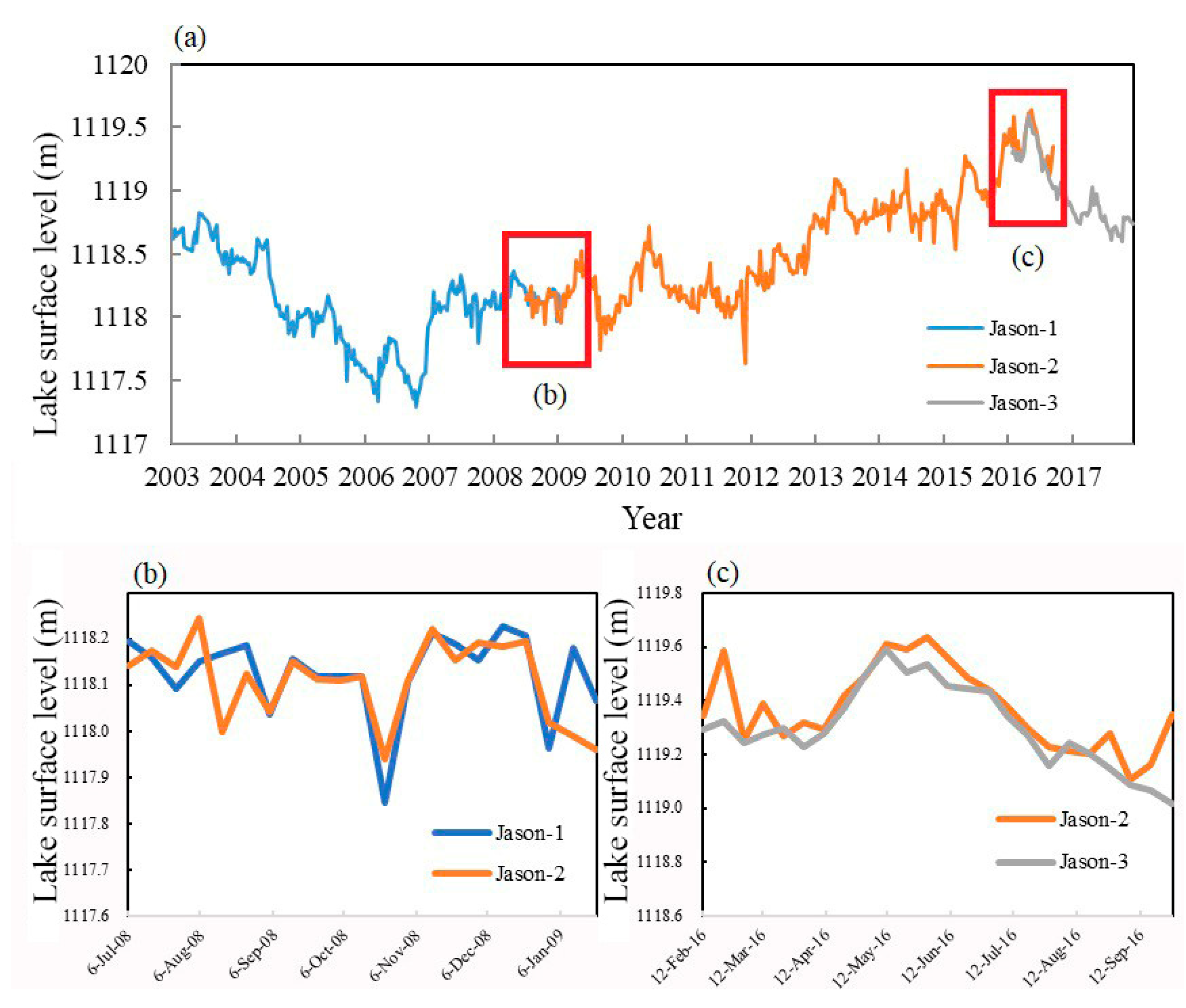
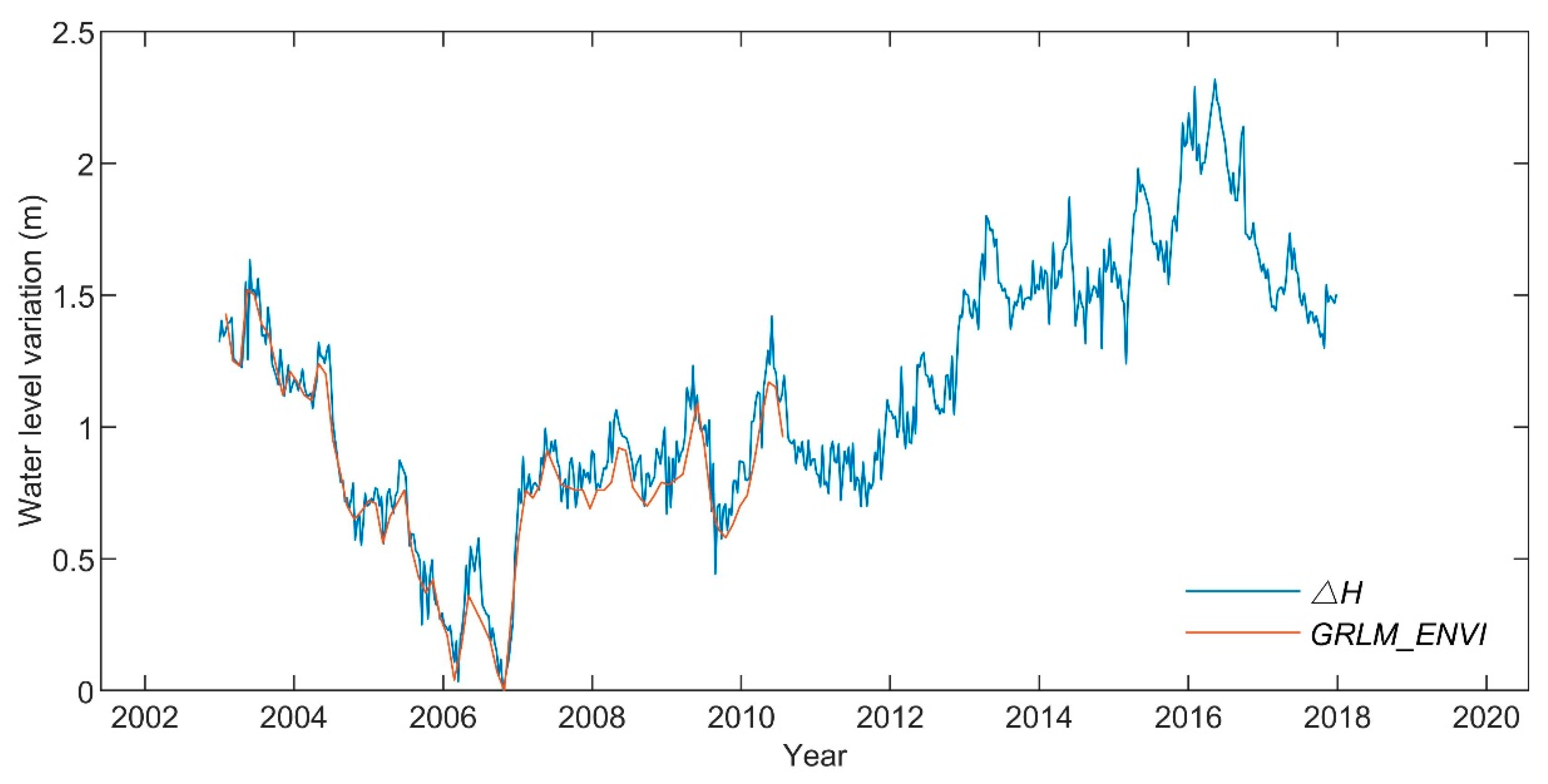
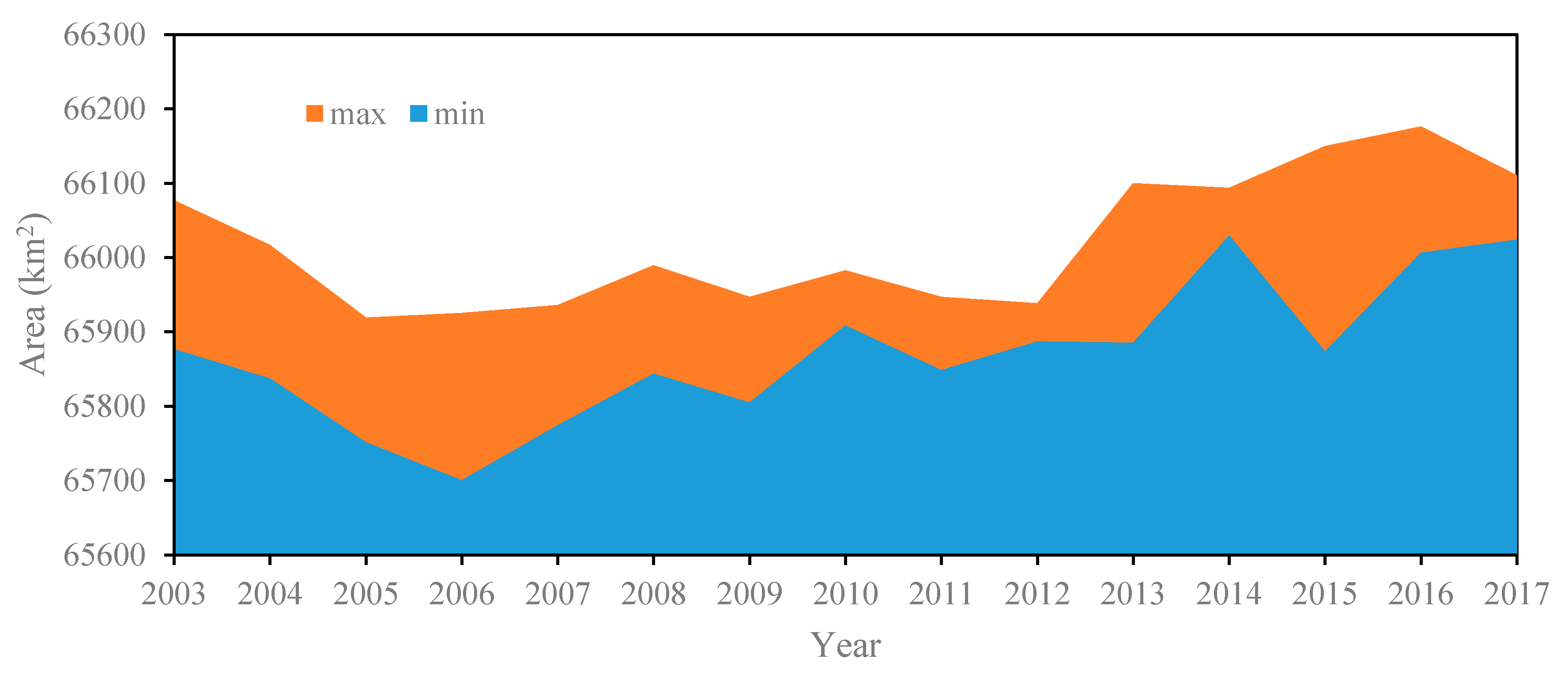


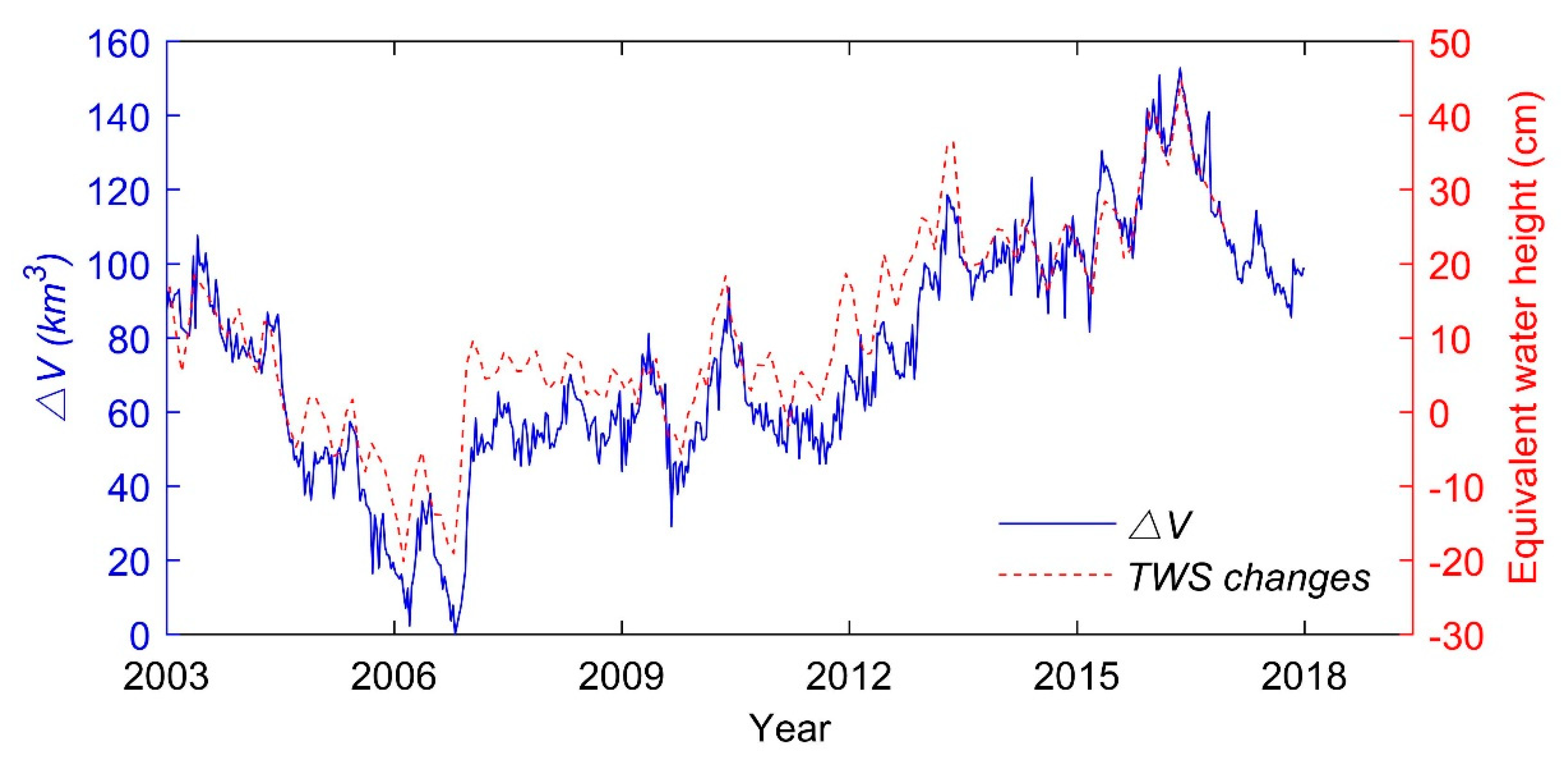
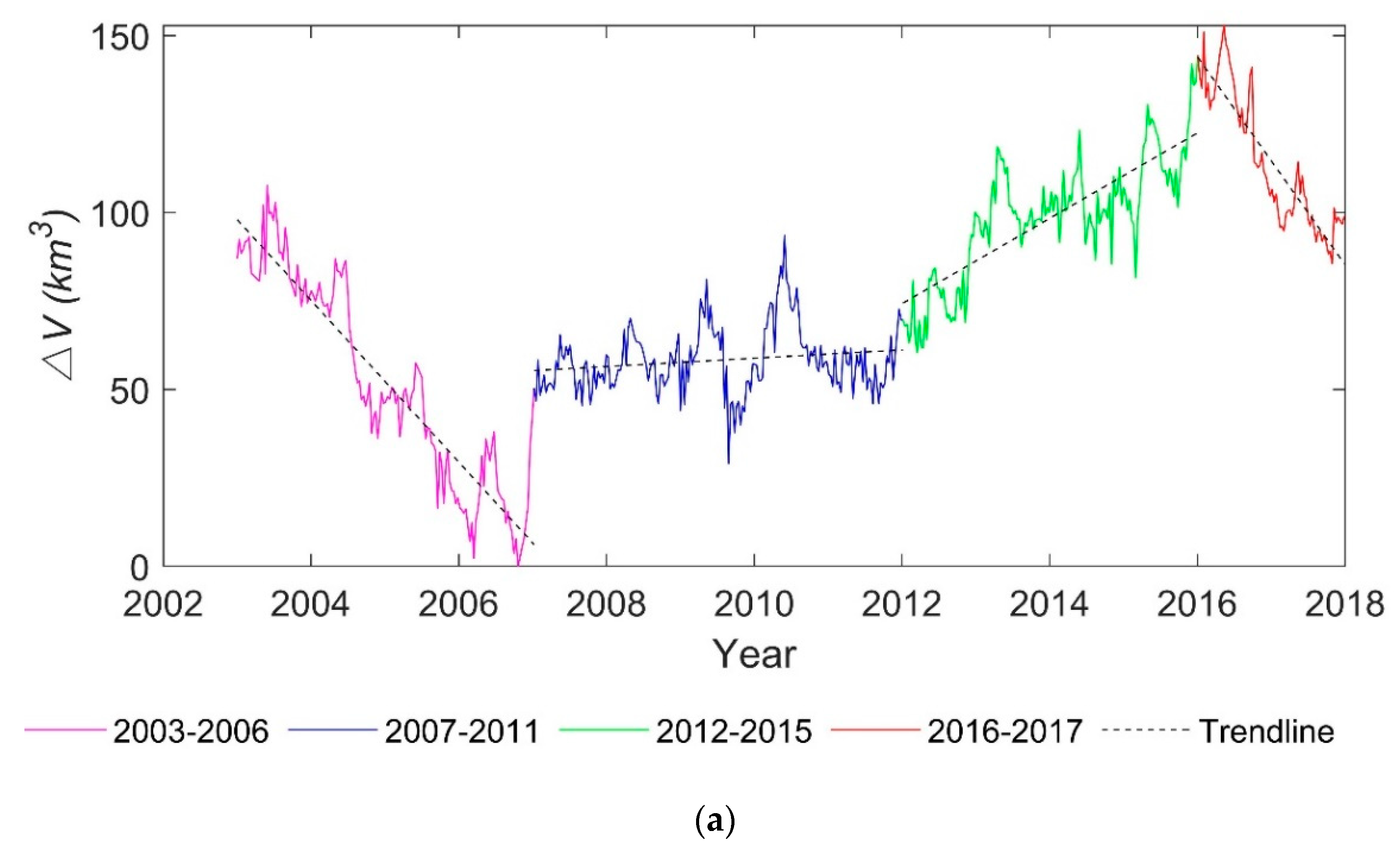
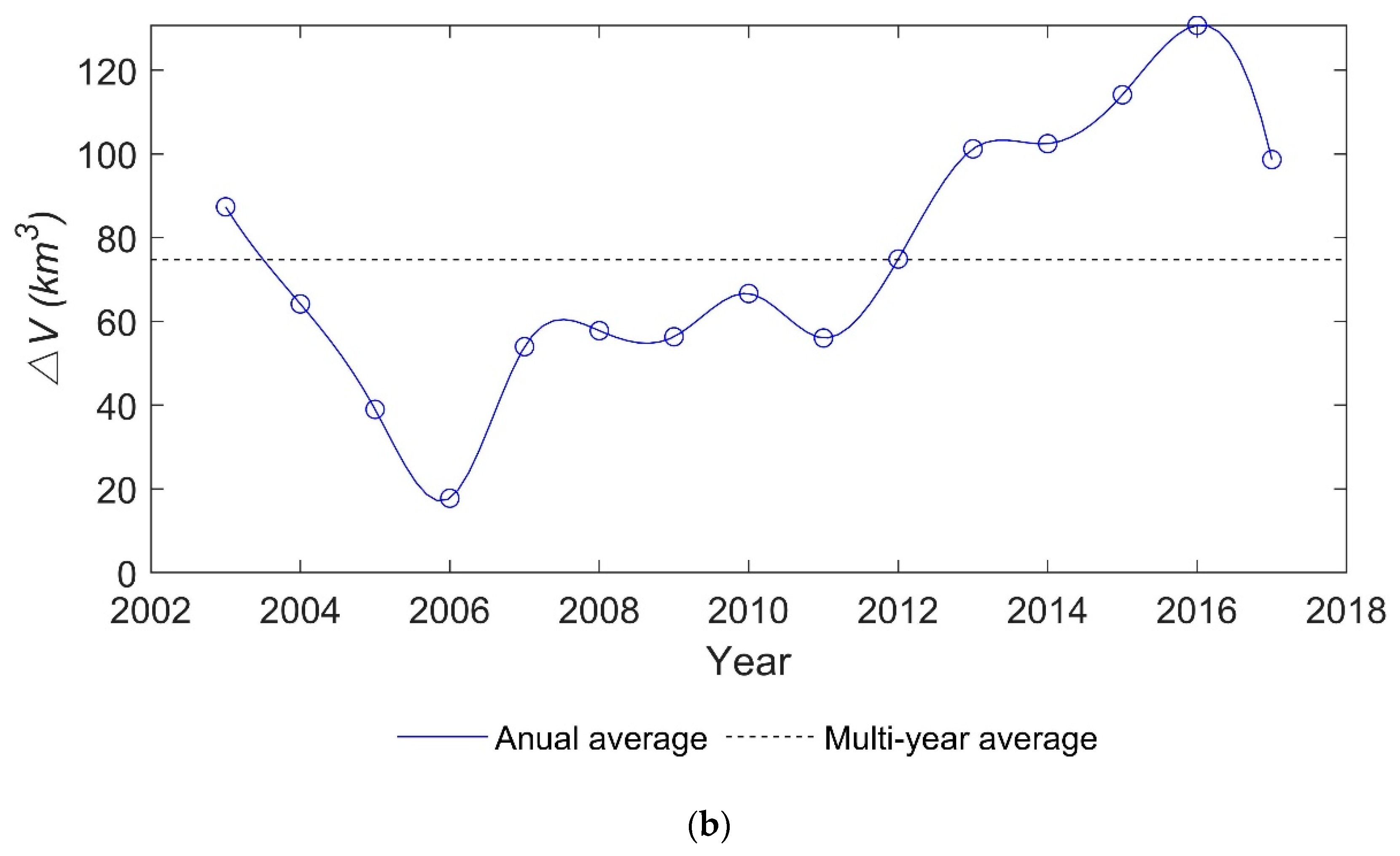



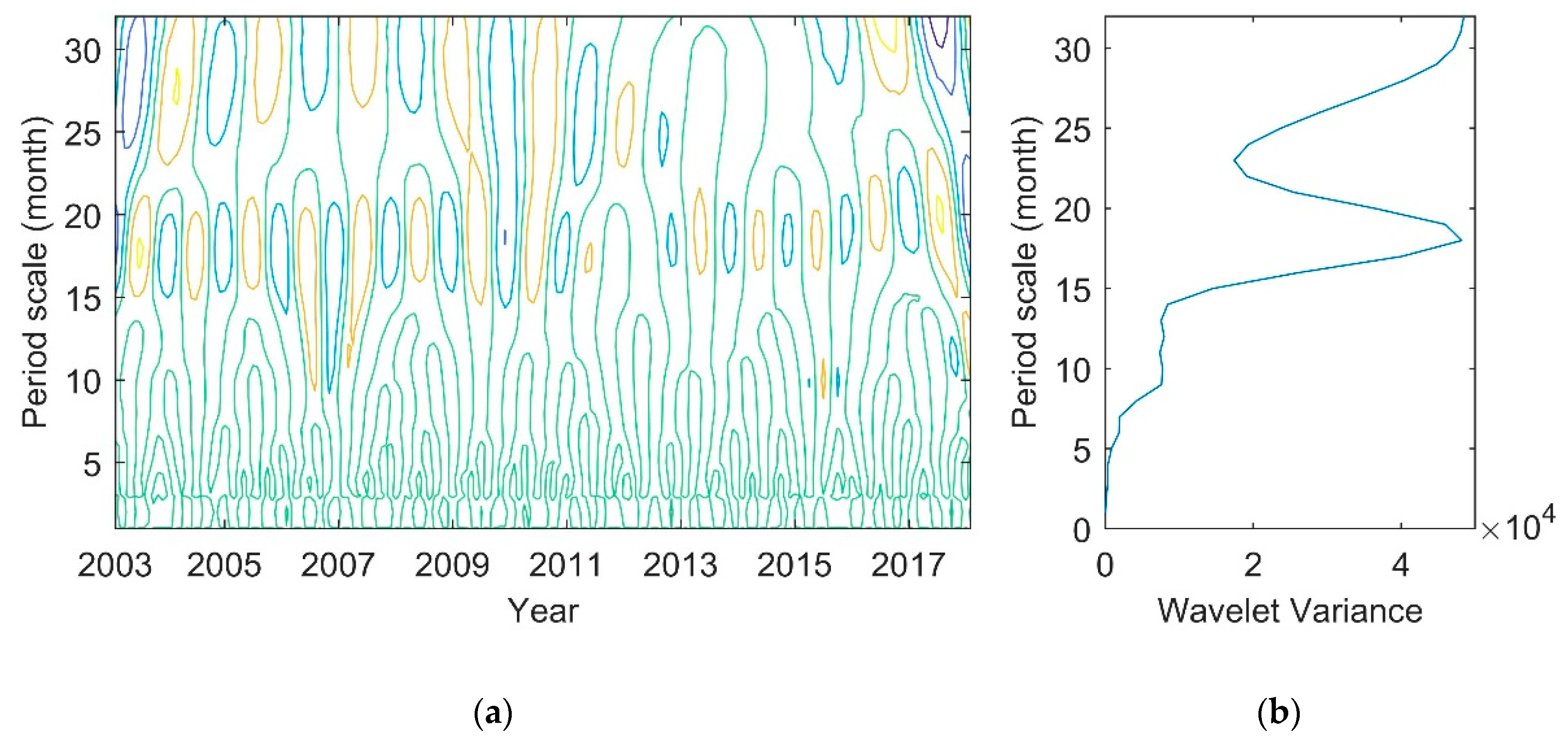
| Description | Source | Study Period | Data Resolution | |
|---|---|---|---|---|
| Spatial | Temporal | |||
| Multi-spectral imagery | MODIS (MOD09A1) [37] | 2003–2017 | 500 m | 8 days |
| Multi-mission altimetry data | Jason-1 [38] | 2003–2012 | - | 10 days |
| Jason-2 | 2012–2016 | - | 10 days | |
| Jason-3 | 2016–2017 | - | 10 days | |
| GRLM_ENVI [39] | 2003–2010 | - | 35 days | |
| Satellite gravimetry | GRACE [40] | 2003–2016 | 0.5° × 0.5° | 1 month |
| Variables | Content | Minimum | Maximum |
|---|---|---|---|
| wet tropospheric correction | −0.5 | −0.001 | |
| dry tropospheric correction | −25 | −1.9 | |
| ionosphere correction | −0.4 | 0.04 | |
| solid earth tide correction | −1 | 1 | |
| pole tide correction | −0.15 | 0.15 |
| Source | Period | Cycles |
|---|---|---|
| Jason-1 | 2003-01-19~2009-01-21 | 250 |
| Jason-2 | 2008-07-06~2016-09-27 | 301 |
| Jason-3 | 2016-02-12~2017-12-27 | 70 |
| Date | MODIS-Derived Area/km2 | Relationship-Derived Area/km2 | Absolute Error 1/km2 | Relative Error 2/% | ||
|---|---|---|---|---|---|---|
| 1 | 2003/1/9 | 1.4032 | 66,001.50 | 66,006.60 | 5.1036 | 0.0077 |
| 2 | 2004/11/8 | 0.6406 | 65,842.25 | 65,825.06 | 17.1926 | 0.0261 |
| 3 | 2005/4/15 | 0.7650 | 65,919.00 | 65,851.20 | 67.8006 | 0.1029 |
| 4 | 2007/12/11 | 0.8264 | 65,936.00 | 65,864.55 | 71.4497 | 0.1084 |
| 5 | 2013/1/17 | 1.4976 | 66,045.75 | 66,032.96 | 12.7886 | 0.0194 |
| 6 | 2017/6/10 | 1.5920 | 66,023.75 | 66,060.27 | 36.5155 | 0.0553 |
© 2020 by the authors. Licensee MDPI, Basel, Switzerland. This article is an open access article distributed under the terms and conditions of the Creative Commons Attribution (CC BY) license (http://creativecommons.org/licenses/by/4.0/).
Share and Cite
Lin, Y.; Li, X.; Zhang, T.; Chao, N.; Yu, J.; Cai, J.; Sneeuw, N. Water Volume Variations Estimation and Analysis Using Multisource Satellite Data: A Case Study of Lake Victoria. Remote Sens. 2020, 12, 3052. https://doi.org/10.3390/rs12183052
Lin Y, Li X, Zhang T, Chao N, Yu J, Cai J, Sneeuw N. Water Volume Variations Estimation and Analysis Using Multisource Satellite Data: A Case Study of Lake Victoria. Remote Sensing. 2020; 12(18):3052. https://doi.org/10.3390/rs12183052
Chicago/Turabian StyleLin, Yi, Xin Li, Tinghui Zhang, Nengfang Chao, Jie Yu, Jianqing Cai, and Nico Sneeuw. 2020. "Water Volume Variations Estimation and Analysis Using Multisource Satellite Data: A Case Study of Lake Victoria" Remote Sensing 12, no. 18: 3052. https://doi.org/10.3390/rs12183052
APA StyleLin, Y., Li, X., Zhang, T., Chao, N., Yu, J., Cai, J., & Sneeuw, N. (2020). Water Volume Variations Estimation and Analysis Using Multisource Satellite Data: A Case Study of Lake Victoria. Remote Sensing, 12(18), 3052. https://doi.org/10.3390/rs12183052







